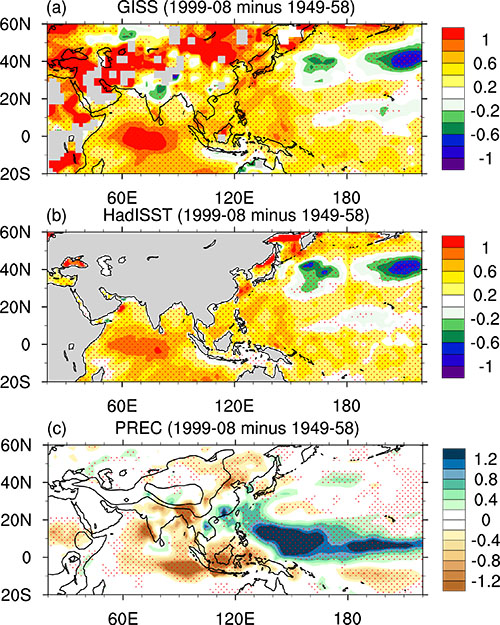The response of monsoon precipitation to global warming, which is one of the most significant climate change signals at the earth's surface, exhibits very distinct regional features, especially over the South China Sea (SCS) and adjacent regions in boreal summer.
To understand the possible atmospheric dynamics in these specific regions under the global warming background, Dr. HE Bian from Institute of Atmospheric Physics, Chinese Academy of Sciences, and Professor YANG Song from Sun Yat-sen University investigate the changes in atmospheric heating and their possible influences on Asian summer climate by both observational diagnosis and numerical simulations.
Results indicate that heating in the middle troposphere has intensified in the SCS and western Pacific regions in boreal summer, accompanied by increased precipitation, cloud cover, and lower-tropospheric convergence and decreased sea level pressure. Sensitivity experiments show that middle and upper tropospheric heating causes an east–west feedback pattern between SCS–western Pacific and continental South Asia, which strengthens the South Asian High in the upper troposphere and moist convergence in the lower troposphere, consequently forcing a descending motion and adiabatic warming over continental South Asia, and leads to less precipitation and therefore weakens the South Asian summer monsoon. When air–sea interaction is considered, the simulation results are overall more similar to observations, and in particular the bias of precipitation over the Indian Ocean simulated by AGCMs has been reduced.

Fig. 1 Difference in JJA mean surface temperature (°C) between high global warming state (1999–2008 mean) and low global warming state (1949–1958 mean) for (a) GISS and (b) SST from HadISST. (c) As in (a) but for precipitation (mm day–1) in PREC. The red dotted areas denote regions where the changes are statistically significant at the 95% confidence level according to the Student's t-test. (He et al., 2016)

Fig. 2 (a) Difference in JJA precipitation (shaded, mm day−1) and 850-hPa winds (vector, m s−1) between HEAT and CON. The red dotted areas denote regions where the changes are statistically significant at the 95% confidence level according to the Student's t-test. (b) As in (a) but for the difference between HEAT_CP and CON_CP. (He et al., 2016)
The result highlights the important role of air-sea interaction in understanding the changes in Asian climate. This study has recently been published in Climate Dynamics in 2016.
Reference:
He, B., S. Yang, and Z. N. Li., 2016: Role of atmospheric heating over the South China Sea and western Pacific regions in modulating Asian summer climate under the global warming background. Climate Dynamics, 46, 2897-2908. DOI 10.1007/s00382-015-2739-2.
Contact: HE Bian, heb@lasg.iap.ac.cn







